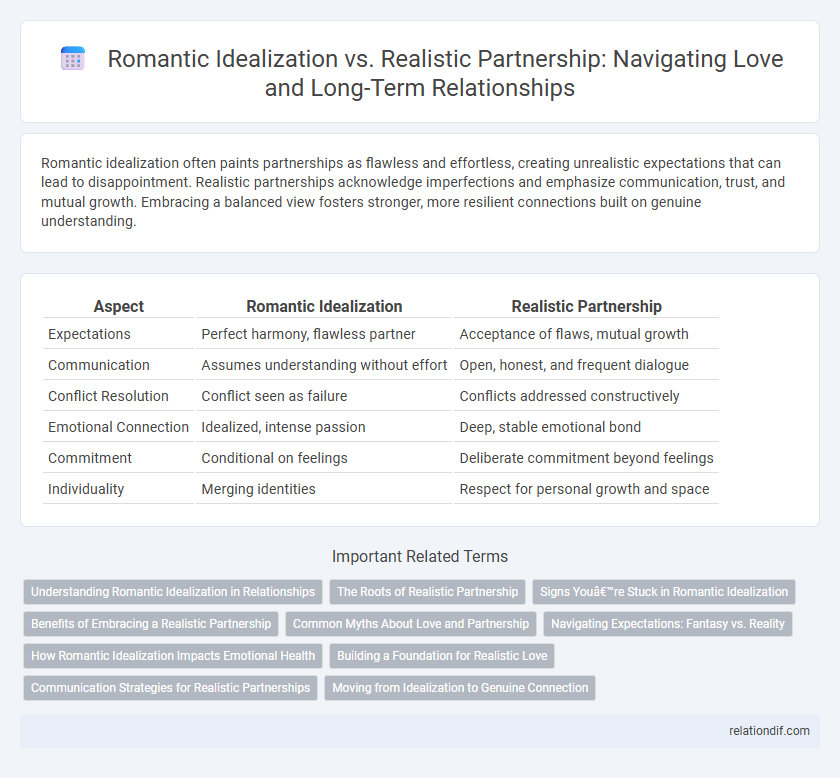Romantic idealization often paints partnerships as flawless and effortless, creating unrealistic expectations that can lead to disappointment. Realistic partnerships acknowledge imperfections and emphasize communication, trust, and mutual growth. Embracing a balanced view fosters stronger, more resilient connections built on genuine understanding.
Table of Comparison
| Aspect | Romantic Idealization | Realistic Partnership |
|---|---|---|
| Expectations | Perfect harmony, flawless partner | Acceptance of flaws, mutual growth |
| Communication | Assumes understanding without effort | Open, honest, and frequent dialogue |
| Conflict Resolution | Conflict seen as failure | Conflicts addressed constructively |
| Emotional Connection | Idealized, intense passion | Deep, stable emotional bond |
| Commitment | Conditional on feelings | Deliberate commitment beyond feelings |
| Individuality | Merging identities | Respect for personal growth and space |
Understanding Romantic Idealization in Relationships
Romantic idealization often distorts partners' true qualities, creating unrealistic expectations that hinder authentic connection and long-term satisfaction in relationships. Understanding this phenomenon involves recognizing cognitive biases and emotional projections that inflate partner virtues while minimizing flaws. Embracing a realistic partnership requires balancing idealistic hope with practical acceptance, fostering deeper intimacy and mutual growth.
The Roots of Realistic Partnership
Romantic idealization often distorts expectations by emphasizing perfection and ignoring individual flaws, while realistic partnership acknowledges and embraces imperfections as part of authentic connection. The roots of realistic partnership lie in mutual respect, open communication, and a shared commitment to growth, fostering resilience through challenges. This approach grounds relationships in truth rather than fantasy, enabling partners to build lasting bonds based on genuine understanding and trust.
Signs You’re Stuck in Romantic Idealization
Fixating on a partner's perceived perfection while ignoring red flags like poor communication, emotional unavailability, or inconsistent behavior signals you're stuck in romantic idealization. Idealizing a relationship often involves dismissing compatibility issues, conflicting values, and unmet needs, which are crucial for realistic partnership growth. Recognizing that love requires mutual respect, vulnerability, and honest evaluation helps shift from fantasy to a grounded, sustainable connection.
Benefits of Embracing a Realistic Partnership
Embracing a realistic partnership fosters deeper trust and resilience by acknowledging imperfections and prioritizing genuine communication. This approach cultivates emotional intimacy and sustainable growth, reducing conflicts born from unmet idealized expectations. Couples grounded in realism build strong foundations that adapt to life's challenges, enhancing overall relationship satisfaction.
Common Myths About Love and Partnership
Common myths about love and partnership often glorify romantic idealization, suggesting love should be effortless and perfect. Realistic partnerships recognize that mutual effort, communication, and compromise are essential for lasting relationships. Understanding these truths helps dispel unrealistic expectations, fostering healthier and more fulfilling connections.
Navigating Expectations: Fantasy vs. Reality
Romantic idealization often paints partnerships with unrealistic expectations, creating a fantasy that overlooks everyday challenges and individual flaws. Navigating expectations requires embracing realistic perspectives, acknowledging both strengths and weaknesses within the relationship. Prioritizing open communication and mutual understanding fosters a balanced connection that thrives beyond idealized notions.
How Romantic Idealization Impacts Emotional Health
Romantic idealization often leads to unrealistic expectations that strain emotional health by fostering disappointment and insecurity when partners inevitably fall short. Psychological studies reveal that individuals who idealize their partners frequently experience heightened anxiety and decreased overall relationship satisfaction. Cultivating a realistic partnership grounded in mutual respect and acceptance significantly supports emotional well-being and sustainable intimacy.
Building a Foundation for Realistic Love
Building a foundation for realistic love involves embracing authentic communication and mutual respect, moving beyond romantic idealization. Couples focusing on shared values, emotional support, and practical compatibility create lasting connections. Understanding imperfections and fostering growth together strengthens the longevity of partnerships.
Communication Strategies for Realistic Partnerships
Effective communication strategies in realistic partnerships prioritize active listening, empathy, and transparent dialogue to bridge the gap between romantic idealization and genuine connection. Couples who engage in honest conversations about expectations, boundaries, and emotional needs foster trust and mutual understanding, strengthening their relationship's foundation. Implementing conflict resolution techniques such as non-judgmental feedback and collaborative problem-solving enhances long-term relationship satisfaction and resilience.
Moving from Idealization to Genuine Connection
Romantic idealization often creates unrealistic expectations that can hinder authentic emotional bonds in partnerships. Embracing genuine connection involves recognizing flaws, communicating openly, and fostering mutual growth beyond fantasy. Developing realistic intimacy strengthens trust and deepens long-term relationship satisfaction.
romantic idealization vs realistic partnership Infographic

 relationdif.com
relationdif.com